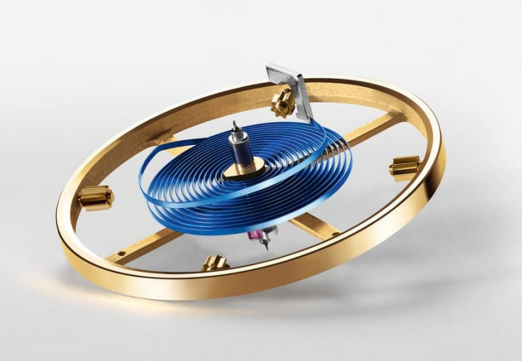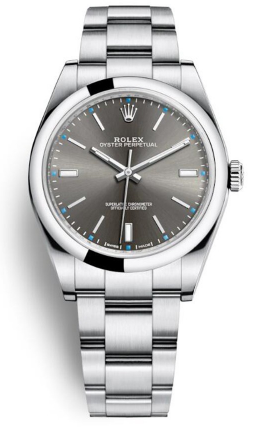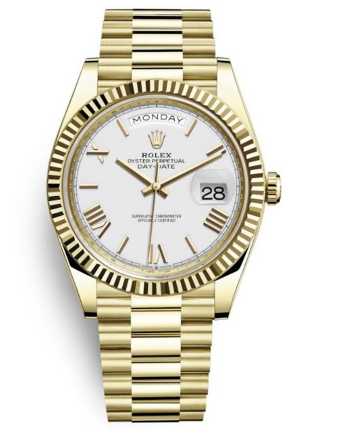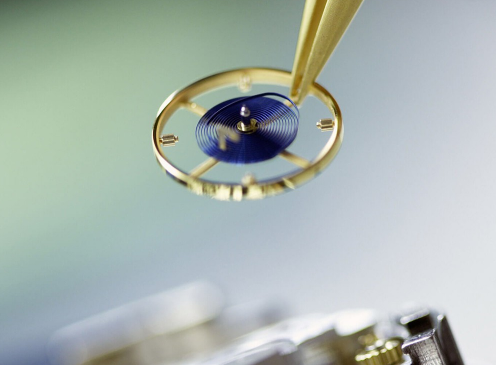If the blue niobium hairspring is so strong, why is Rolex still coming out with a silicon hairspring?
Today, I want to talk about a technical issue. The hairspring is one of the most important parts of a mechanical watch, which has a great influence on the timing of the watch. From ancient times to the present, the major watch manufacturers and brands are constantly researching and improving the REPLICA ROLEX WATCHES performance of the hairspring. Among them, Rolex has been in the lead.

Rolex Parachrom Blue Niobium hairspring is one of the best performance hairsprings among watches.
A hairspring, in essence, is a very, very thin spring. The elastic hairspring is released and retracted to drive the balance wheel to swing back and forth. So the performance of the hairspring, directly affects the watch time accurate or inaccurate. If you have a watch with a transparent bottom, you can see that the hairspring is very, very thin, about the same diameter as a hair. Because the hairspring is so fine, the biggest technical problem is that it is very susceptible to external influences. There are several major factors that can affect the normal operation of the balance spring: temperature, magnetic field, shock, vibration and so on.


In 2000, Rolex launched the Parachrom hairspring for the first time, which solved all the technical problems of the hairspring and effectively “defended” against all external “disturbances”. The reason for this is that the Rolex Parachrom hairspring is made of niobium-zirconium. The niobium-zirconium hairspring is also known as a blue niobium hairspring because of its blue colour.
The Nivarox hairspring is an iron-nickel alloy hairspring with chromium and cobalt added.
Here, we can see that the Rolex Parachrom hairspring is a niobium-zirconium alloy hairspring and the Nivarox hairspring is an iron-nickel alloy hairspring, the two components are different. The reason why Rolex uses niobium-zirconium alloy is to avoid the iron contained in the Nivarox hairspring, while the Rolex Parachrom hairspring does not contain iron, although the Nivarox hairspring has a certain anti-magnetic ability, but the small amount of iron in the Nivarox hairspring will make the hairspring to be magnetized. As long as there is iron in the hairspring, there is a possibility that it will be magnetized. The Rolex Parachrom hairspring, which contains no iron at all, eliminates the influence of magnetic fields.

According to Rolex officials, the Parachrom blue niobium hairspring is not affected by magnetic fields, is insensitive to temperature changes and is 10 times more resistant to shocks than a conventional hairspring. Now, the Rolex Super Chronometer, with an error standard of -2 to +2 per day, is proof of the robustness of the Rolex Parachrom Blue Niobium hairspring. In such a large number of mass-produced watches, none other than Rolex has such a high standard of timing (referring to the full range of mass-produced watches), the Parachrom niobium hairspring is a “perfect” hairspring.
From the above, the Parachrom niobium hairspring is “perfect”, but Rolex is still not satisfied with it. To be honest, Rolex’s pursuit of technical perfection is astonishing. If we look at it from the point of view of absolute perfection, one of the disadvantages of a normal hairspring is that the traditional way of fixing the hairspring destroys the shape of the hairspring. Generally the hairspring is fixed in such a way that one end is fixed to the inner stump of the hairspring and one end is fixed to the outer stump of the hairspring. Some tables use clips to fix the hairspring, some use glue to stick the hairspring. With one end of the spring fixed to the outside and one end fixed to the inside, this is not conducive to the desired symmetrical, horizontal shape of the spring (many brands use a silicon spring, but it is also fixed in this way). (Many brands use a silicone hairspring, but this is also the case.) Although this effect is very minor, Rolex is notorious for not being able to get enough of it.
In 2014, Rolex launched the Syloxi silicon hairspring for the first time. Silicon hairspring you are very familiar with, now many brands are fully popularized silicon hairspring, silicon hairspring’s anti-magnetic ability is very prominent. But Rolex’s Syloxi silicon hairspring and general silicon hairspring are different.Syloxi silicon hairspring completely changed the hairspring fixed way, Syloxi silicon hairspring no longer use any clips, and is no longer fixed at one end of the hairspring inside the pile, one fixed on the outer pile. We can see that the Rolex Syloxi silicon hairspring is completely horizontal and symmetrical shape, on both ends of the hairspring, there are two holes, the two ends of the hairspring is fixed directly on the balance plate. This ensures that the Syloxi silicon hairspring has the ideal horizontal, symmetrical shape (the silicon hairspring is manufactured by photo-etching in one piece, so the ideal shape can be made).
The official Rolex description of the Syloxi silicon hairspring is that “the Syloxi hairspring is not disturbed by magnetic fields, remains extremely stable even in the face of temperature variations, and is ten times more resistant to shocks than a conventional hairspring. Its patented geometry allows the movement to remain regular in any position.” Of these, the last sentence, “Its patented geometry allows the movement to remain regular in any position,” is not found in the description of the Rolex Parachrom Blue Niobium hairspring, and is where the Syloxi silicon hairspring surpasses the Parachrom Blue Niobium hairspring.
Rolex currently uses the Syloxi silicon hairspring only in the 2236 caliber, a movement dedicated to Rolex women’s watches, used in women’s watches, mainly women’s logs (31mm and 28mm women’s watches), as well as 37mm yachts. The use of the Syloxi silicon hairspring in small women’s watch movements helps to improve the timing performance of women’s watches.
In Rolex men’s watches, Parachrom blue niobium hairsprings are used. Nowadays, many brands use a silicon balance spring for all their watches, but why does Rolex use it only on a small scale in women’s watches? There are views that the silicon hairspring from the performance point of view, there are advantages. However, in the long run, over the next decade or two, the silicon balance spring is not repairable because it is made in one piece, and when the current watch becomes an “antique watch”, if the silicon balance spring fails, it may not be repairable or it may not be possible to reproduce a matching balance spring. Rolex, as a brand that values its watches over the long term (including vintage watches), will probably use the Parachrom Blue Niobium balance spring as its mainstay for the long term, and only use silicon balance springs in small quantities.
The Syloxi silicon balance spring is perfect, but from a practical point of view, the Parachrom Blue Niobium balance spring is good enough and is the best choice.
Apart from Rolex, many brands have recently started to redevelop new alloy hairsprings (the Swatch Group and Audemars Piguet have developed a new Nivachron alloy hairspring), which will probably replace the silicon hairspring in the future. (Photo/text by Yan Ping, House of Watches)